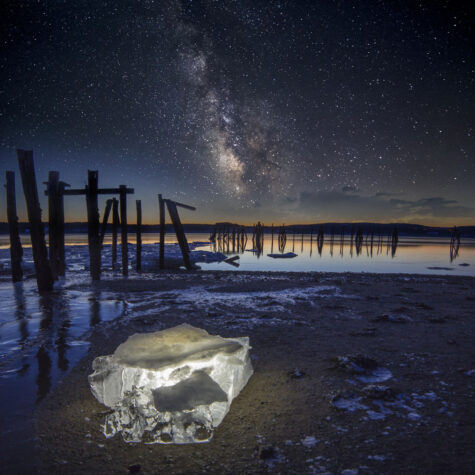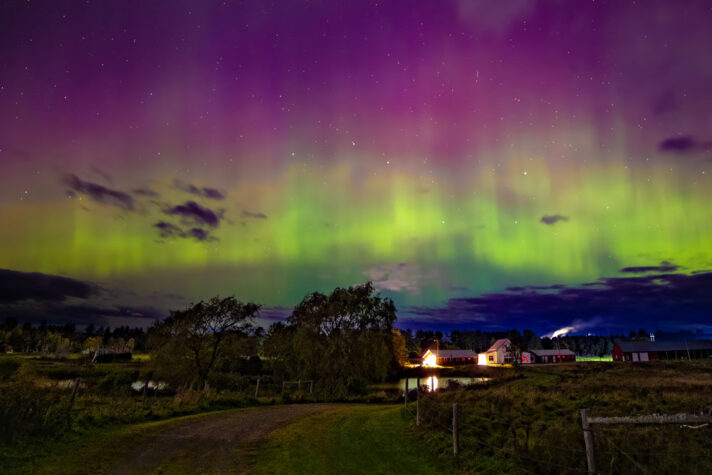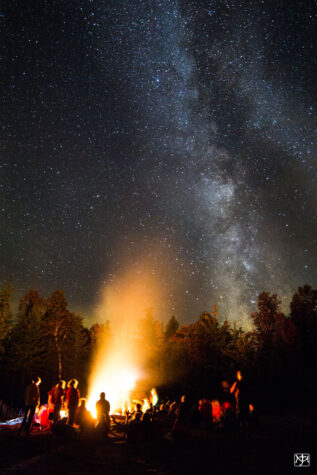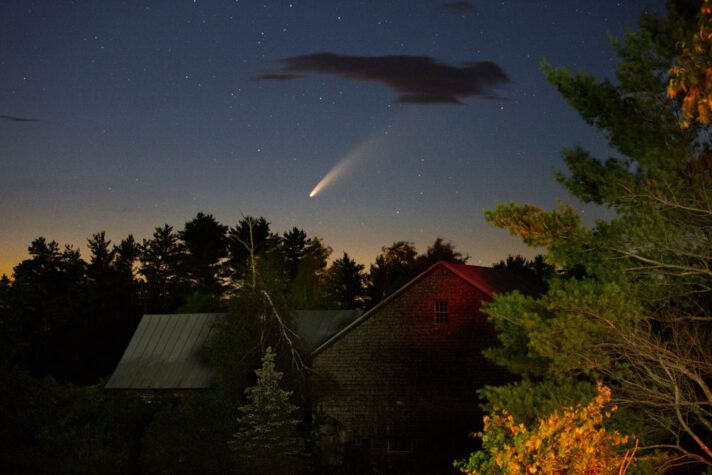Catch John Meader’s Astrophotography at the Margaret Chase Smith Library
On view until September 15, the exhibition combines politics and Maine’s night sky
“I am sure you recognize that the United States needs to lead in space for several reasons, each of which will contribute to the scientific, technological, or economic advancement, or to the peace and security of the free world.”
—Senator Margaret Chase Smith, from a speech at George Washington University,
January 19, 1963
A visit to the Margaret Chase Smith Library begins in a room with a dramatic, vaulted ceiling adorned with 95 convocation robes, one for each of the honorary degrees Margaret Chase Smith received in her lifetime. Set in a leafy residential neighborhood of Skowhegan, the library complex encompasses a museum, congressional archives, and Smith’s historic home, which she designed in the 1940s to include a great room with modern floor-to-ceiling windows overlooking the Kennebec River, as well as a “presidential” guest room where Eisenhower napped during his visits. To the left of the library entrance, the exhibition Perspectives on the Night Sky: Astrophotography by John Meader is installed in a large multipurpose room alongside display cases of Smith’s papers, rocket models, and ephemera from her years in government, when she was a crucial voice in support of the fledging space program. It’s an exciting juxtaposition: Meader’s arresting photographs of the night sky alongside museum artifacts that show Smith’s influence on the birth of NASA. “Margaret Chase Smith’s advocacy made the technology behind John Meader’s work possible,” observes Christopher O’Brien, a historian of the Cold War and the library’s executive director.
Margaret Chase (1897–1995) grew up in Skowhegan. She achieved a high school education, and then, unable to afford college, she exercised her brilliant mind and expanded her social network through early employment as a teacher, reporter, and business executive and through her engagement in political organizations. Her marriage to Clyde Smith, a local entrepreneur and rising political star, was described by both as a business partnership, with Clyde ultimately entrusting Margaret to run for his House seat after he suffered a heart attack in 1940. She won his seat in a special election; he died later that year, and she went on to serve multiple terms, always winning more than 60 percent of the vote. She was the first woman in U.S. history to serve in both the House and Senate, and one of the first to run for president. Throughout her congressional tenure, she supported Maine’s defense industry; the nascent space program was viewed at the time as being important to the country’s defense. The allure of space travel likely appealed to her adventurous spirit as well. In 1957 she suited up in flight gear (and high heels!) for a flight on an Airforce F-100 Super Sabre jet and became the first congresswoman to break the sound barrier.
Meader spent childhood summers at Oaks Pond in Skowhegan, in love with the outdoors, insatiably curious, and always up for adventure. He was a student in 1979 when he and fellow students began running planetarium shows at the University of Maine, never dreaming that within ten years he would found Northern Stars Planetarium with the purchase of a portable, inflatable planetarium. He was given a decent film camera when he graduated from college and spent many years photographing his daily life and the natural world, the camera inseparable from him, like an extension of his hand, and increasingly informing the way he saw the world. When digital photography emerged as a new, more forgiving medium and one especially suited to shooting at night, Meader converted. “Digital photography really changed my relationship with photography; it became an art form for me.”
All of Meader’s work has a deep connection to story, and the content of the foreground is often the point of departure as well as a grounding element. In River Berg and the Milky Way, the subject of the image may be that gorgeous Milky Way, but the eerie glow from the chunk of river ice in the foreground is where the story begins. Sometimes Meader and his camera are under the night sky for hours on end, during some of the most unusual, elusive, and spectacular events in the natural world. However, he is not a documentarian. “I’m trying to create a mood, a sense of what it was like to be there,” he says of this body of work dedicated to the night sky and celestial events. “Being there” is a labor of time and love in changeable outdoor settings: creating an image of a celestial event in the night sky with the Earth in constant motion requires the technical skill of tracking stars, plus patience, endurance, and a high tolerance for repetitive tasks. Each image can take hours of processing time: Meader digitally knits multiple frames together to produce a composite, which he may further alter to achieve an expression of what he has witnessed with his own eyes. The stunning, dynamic Star Trails over Lake George, which Meader shot in Canaan on August 24, 2023, is a composite of approximately 42 frames, each 30 seconds long, and combined to capture the star trails. The Total Eclipse Sequence Montage 2017 comprises more than 40 frames, including 33 for the sequence and 7 for the large eclipse at the center, all shot at different speeds to capture the changing light. “Our eyes have a greater dynamic range than a camera,” he explains, and while all astrophotography is constructed, it is also as true as a plein air painting begun in the landscape and finished in the studio. In both, the artist makes decisions in the studio, drawing on a memory and a deep understanding of the circumstances of light, shading, movement, color, and mood in the observed landscape.
“I like where night photography takes me,” Meader says. He’s talking about the inherent adventure of seeking out far-flung locations and celestial events worldwide as well as his love for the artistic process, which he calls the “journey to the image.” Like Margaret Chase Smith, who traveled extensively throughout her life, Meader approaches all aspects of his work as a lifelong learner. What better place than a library for us to get to know them both, and to celebrate the intersections of their work.
Perspectives on the Night Sky: Astrophotography by John Meader will be on view at the Margaret Chase Smith Library in Skowhegan until September 15, 2025.




